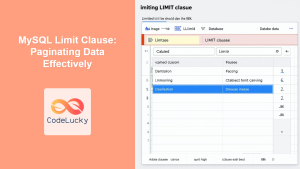In the world of database management, efficiency is key. When working with large datasets, retrieving all records can be time-consuming and resource-intensive. This is where the SQL SELECT TOP clause comes into play, offering a powerful tool to limit the number of results returned by a query.
Understanding the SELECT TOP Clause
The SELECT TOP clause is used to specify the number of records to return in the result set. This clause is particularly useful when you're dealing with large tables and you only need to see a sample of the data or when you're looking to improve query performance.
🔍 Note: The exact syntax of the TOP clause can vary depending on the database management system you're using. We'll cover the most common variations in this article.
SQL Server Syntax
In SQL Server, the TOP clause is used directly after the SELECT statement. Here's the basic syntax:
SELECT TOP (n) column1, column2, ...
FROM table_name
WHERE condition;
Where 'n' is the number of records you want to return.
Let's look at a practical example. Suppose we have a table called 'Products' with the following data:
| ProductID | ProductName | Price | Category |
|---|---|---|---|
| 1 | Laptop | 999.99 | Electronics |
| 2 | Smartphone | 599.99 | Electronics |
| 3 | Headphones | 149.99 | Electronics |
| 4 | Desk Chair | 199.99 | Furniture |
| 5 | Coffee Maker | 79.99 | Appliances |
| 6 | Blender | 59.99 | Appliances |
| 7 | Bookshelf | 129.99 | Furniture |
To retrieve the top 3 most expensive products, we could use:
SELECT TOP (3) ProductName, Price
FROM Products
ORDER BY Price DESC;
This query would return:
| ProductName | Price |
|---|---|
| Laptop | 999.99 |
| Smartphone | 599.99 |
| Desk Chair | 199.99 |
💡 Pro Tip: Always use ORDER BY with TOP to ensure consistent results, especially when dealing with ties.
Using TOP with PERCENT
SQL Server also allows you to use TOP with a percentage. This is particularly useful when you want to retrieve a certain percentage of records from a table.
SELECT TOP (50) PERCENT column1, column2, ...
FROM table_name;
For example, to get the top 50% most expensive products:
SELECT TOP (50) PERCENT ProductName, Price
FROM Products
ORDER BY Price DESC;
This would return:
| ProductName | Price |
|---|---|
| Laptop | 999.99 |
| Smartphone | 599.99 |
| Desk Chair | 199.99 |
| Headphones | 149.99 |
Using TOP with TIES
When using TOP, you might encounter situations where multiple rows have the same value in the column you're ordering by. By default, SQL Server will arbitrarily choose which of these "tied" rows to include. If you want to include all tied rows, you can use the WITH TIES option.
SELECT TOP (n) WITH TIES column1, column2, ...
FROM table_name
ORDER BY column_name;
Let's say we want the top 2 most expensive products, but we want to include any products tied for second place:
SELECT TOP (2) WITH TIES ProductName, Price
FROM Products
ORDER BY Price DESC;
This would still return just the laptop and smartphone, as there are no ties for the second-highest price.
MySQL and PostgreSQL Syntax: LIMIT
While SQL Server uses TOP, MySQL and PostgreSQL use the LIMIT clause to achieve the same result. The LIMIT clause is placed at the end of the query.
SELECT column1, column2, ...
FROM table_name
WHERE condition
LIMIT n;
To get the 3 most expensive products in MySQL or PostgreSQL:
SELECT ProductName, Price
FROM Products
ORDER BY Price DESC
LIMIT 3;
This would return the same result as our earlier SQL Server example.
🔔 Important: In PostgreSQL, you can use FETCH FIRST n ROWS ONLY instead of LIMIT for standard SQL compliance.
Oracle Syntax: ROWNUM
Oracle databases use a different approach. Instead of a TOP or LIMIT clause, Oracle uses the ROWNUM pseudo-column.
SELECT column1, column2, ...
FROM table_name
WHERE ROWNUM <= n;
However, this approach can lead to unexpected results when combined with ORDER BY. To get the correct top n rows, you need to use a subquery:
SELECT * FROM (
SELECT ProductName, Price
FROM Products
ORDER BY Price DESC
)
WHERE ROWNUM <= 3;
This will give us the same top 3 most expensive products as in our previous examples.
Combining TOP with WHERE Clause
The TOP clause can be combined with WHERE to filter records before limiting the result set. This can be particularly useful for complex queries.
For example, let's say we want to find the top 2 most expensive electronic products:
SELECT TOP (2) ProductName, Price
FROM Products
WHERE Category = 'Electronics'
ORDER BY Price DESC;
This would return:
| ProductName | Price |
|---|---|
| Laptop | 999.99 |
| Smartphone | 599.99 |
Performance Considerations
Using the TOP clause can significantly improve query performance, especially when dealing with large tables. By limiting the number of rows returned, you reduce the amount of data that needs to be processed and transferred.
🚀 Performance Tip: When possible, use TOP in combination with appropriate indexing for optimal query performance.
Common Pitfalls and Best Practices
-
Inconsistent Results: Without an ORDER BY clause, the rows returned by TOP are not guaranteed to be in any particular order. Always use ORDER BY for consistent results.
-
TOP vs. LIMIT: Remember that TOP is specific to SQL Server. If you're working with multiple database systems, be aware of the syntax differences.
-
Subqueries: When using TOP in a subquery, be cautious about the order of operations. The TOP clause is applied before the ORDER BY in subqueries.
-
Pagination: While TOP is useful for getting the first n rows, it's not ideal for pagination. For that, you'd typically use OFFSET and FETCH or a similar mechanism.
Conclusion
The SQL SELECT TOP clause is a powerful tool for limiting query results, improving performance, and focusing on the most relevant data. Whether you're using SQL Server's TOP, MySQL's LIMIT, or Oracle's ROWNUM, understanding how to effectively limit your query results is crucial for efficient database management.
By mastering the use of TOP and its equivalents, you'll be able to write more efficient queries, improve application performance, and more easily work with large datasets. Remember to always consider the specific needs of your application and the capabilities of your database system when using these clauses.
Happy querying! 🎉



















